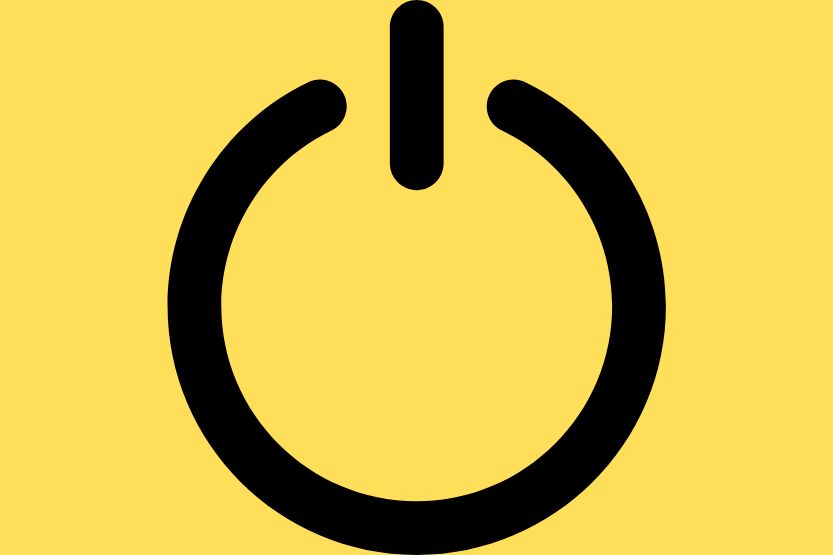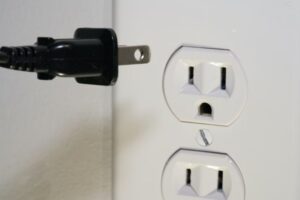You’ve probably seen the I/O on/off switch on many home appliances and gadgets and always got confused. What do the “I” and “O” symbols mean? In this article, you’ll learn the origin and meaning of these power switch on/off symbols.
According to the International Electrotechnical Commission (I.E.C.) 60417-5010 standard, the on-off power symbol, a vertical line partially within a broken circle, toggles any device between on and off. Meanwhile, a crescent moon symbol means sleep mode. The Institute of Electrical and Electronics Engineers (IEEE) added it to replace the standby mode symbol.
Read on to learn more about these I.E.C.-designated off/on switch symbols.
Origin of the “I” and “O” Power Switch Symbols

Most modern electronic devices have a power button or switch marked by a vertical line (“I”) and a full circle (“O”) symbol at the top. This symbol indicates their on-off states.
However, it wasn’t always this way. In the past, power switches had a lever or slider that you could push to the “ON” or “OFF” position.
When and why were the “ON” and “OFF” power symbols replaced with the vertical line and full circle? Do all manufacturers all over the world use these power switch symbols?
On and Off Label during the World War II
Around World War II (1939–45), most power switches were still labeled “ON” and “OFF.”
Need to Create a Simpler Label
But as the trade of electronic products started to become global and technology continued to advance, there was a need to create simpler and more compact labeling that non-English-speaking people could also understand. That’s where the idea of using 0 (zero) and 1 (one) came from.
Utilized the Binary System
During World War II, engineers already used the internationally-recognized binary system to label power buttons and switches. The binary system is a base-2 number system in computer science and mathematics.
This means the numbers and values are expressed through only two digits: 0 and 1. On a power switch, “0” represents “off,” while “1” represents “on.”
If you always get confused about whether you turned on or off the switch, the simplest way to remember the functions of the full circle and vertical line is to think of them as a “1” and a “0”:
- 0 means false, off, or low voltage
- 1 means true, on, or high voltage
I.E.C. Combined “I” and “O” Into One Universal Symbol
Then came 1973. At the time, the International Electrotechnical Commission or I.E.C. combined these two symbols (“I” and “O”) into one universal symbol that manufacturers widely use today.
The I.E.C. was established in London in 1904. It’s a non-profit, non-governmental organization that sets and establishes international standards for technologies run by electricity.
I.E.C. Introduced the Universal Power Symbols Through the “I.E.C. 60417” Database
The I.E.C. introduced the universal power symbols through the “I.E.C. 60417: Graphical Symbols for Use on Equipment” database. But the graphical power symbol included in the collection stands for “standby.”
This means that the device doesn’t completely cut off the power; instead, it goes into a low power state. In other words, the device is in sleep mode.
This explains why some electronic appliances or gadgets have a different switch for completely cutting off the power supply. Also, these devices with a standby mode can still be turned on with remote control because, in reality, they can resume operation from sleep almost instantly.
5 Main Types of Power Symbols and Their Meaning
You’ve probably encountered these power symbols countless times but are still having trouble understanding the on/off switch symbol meaning. So, to clarify things, let’s dive deeper into defining the five main types of power symbols:
1. Standby
The I.E.C. 60417-5009 is the standby power symbol, a vertical line within a broken circle. This usually appears opposite the switch for turning on a device. It could also appear alone on a push button, putting a device in standby mode or toggling between on and standby.
A device on standby mode still consumes electricity, even if you turn the system off. This is also referred to as “soft power off” or “soft reset.” That’s why you often see the standby button or symbol on most laptops and desktop computers.
2. Power-On
The symbol I.E.C. 5007 indicates that a device is in a fully powered state. It appears as an “I” (small vertical line) on a push button or one side of a toggle switch.
3. Power-Off
It’s easy to remember what the symbol I.E.C. 5008 is for. The symbol for the I.E.C. 5008 is a circle (without any line). If the toggle switch is flipped to the “O” side, a device is completely disconnected from the power supply.
4. Sleep-Mode
In the past, there was still a lot of confusion about the meaning of the standby symbol (I.E.C. 60417-5009)—at least not until you tried the device’s power switch.
So, the Institute of Electrical and Electronics Engineers (IEEE) stepped in to say that the standby symbol should be used on a single button to indicate “power.”
5. Crescent Moon
Together with the California Energy Commission, the IEEE proposed that there should be a different symbol for a low-power state: a crescent moon. They published this proposal as the IEEE standard 1621 in 2004.
You’ll typically see the crescent moon symbol on the keyboard or the front of a computer or laptop to put it into sleep mode. Pressing any keys or moving your mouse should quickly wake up your computer or laptop.
The purpose of this power option is to conserve energy and ensure that the programs you’ve left open remain the same as when you put your computer to sleep.
So, how do the standby definitions of the IEEE standard 1621 and I.E.C. 60417 differ? Aside from introducing the new symbol for “standby,” the IEEE also defined the I.E.C. 60417-5009 as “soft-off”—even if it’s unknown whether a device consumes absolute zero power.
What Do Power Button Symbols Mean on Computers or Laptops

Most of the power on-off symbols discussed in this article are widely used in desktop computers and laptops.
On computers, you’ll find the power button in the middle center or top-right corner of the central processing unit (CPU) case. Laptops have it along the side (left, right, back, or front) or above the keyboard.
Power Icons and Buttons
But for this discussion, let’s focus on laptops’ power icons and buttons.
Laptops don’t use the “I” (on) and “O” (off) symbols to indicate the power status and the remaining battery time. Instead, you’ll usually find these power icons:
- A crescent moon that represents ‘Sleep’
- A “line within a broken circle” icon that represents on and off
- A circular-arrow icon that represents ‘Restart.’
- An analog clock icon that represents ‘Hibernate.’
Depends on the Operating System
Unlike other electronic devices, the meaning of power symbols in laptops and desktops could change depending on their operating system. For instance, you can configure the power setting in the Windows Operating System to change what happens when you press the power button or close the lid.
How to Change the Power Symbols’ Function on Windows-operated Laptops or Desktops
Below are the general steps for changing the function of power symbols on Windows-operated laptops or desktops:
- Open the following in sequence: click the “Start” menu, then “Settings,” “System,” “Power & sleep settings,” and “Additional power settings.”
- You could also access (in sequence) the power options this way: Click the “Start” menu, then “Windows system,” “Control Panel,” and “Power Options.”
- Once you get to the “Power Options,” perform any of the following:
- Click the “Choose what the power buttons does” setting.
- Next to the “When I press the power button” setting, click the drop-down menu to choose what happens when you push the power button when you plug in your desktop or laptop. Your options are “Do nothing,” “Sleep,” “Hibernate,” “Shut down,” and “Turn off the display.”
- If you’re using only your laptop, you can choose what happens when you close the lid. Select “Choose what closing the lid,” and then next to the “When I close the lid” setting, select “Do nothing,” “Sleep,” “Hibernate,” or “Shut down.”
- Don’t forget to save the changes you made.
Again, is the O or I on? The I and O symbols on switches came from the binary system, wherein 1 or | means on, while 0 means off.
What Does the Standby Symbol Mean in Popular Culture
The power symbols aren’t just popular among tech enthusiasts. You can also find the standby symbol in different areas of pop culture—from fashion to television series:
Fashion
In fashion, large versions of the standby symbol are printed on apparel, such as hoodies and t-shirts. There’s even one open-source hardware company designed glowing and pulsating cuff-links inspired by the standby symbol.
Music
Any 90s kid into rock music would’ve heard of the popular American rock band Garbage. The cover art for their single “Push It” featured the standby symbol.
TV Shows
You’ve probably spotted this popular power symbol in some television shows. In “Sense8,” the main character Nomi Marks, a hacktivist and political blogger, has a tattoo of the standby symbol behind her right ear.
Meanwhile, the second letter “O” in the post-apocalyptic sci-fi television series titled “Revolution” was stylized with the same symbol.
Animation
In the Japanese animation “Dimension W,” the main protagonist Kyouma Mabuchi wears a distinct clothing style. He wears a happi coat, a traditional lightweight cotton jacket with baggy sleeves, with a light-colored standby symbol on the back.
Artworks
You may also see it in artworks once in a while. The I.E.C. Subcommittee 3C created a power symbol artwork, which was part of the “This is for Everyone: Design Experiments for the Common Good” exhibition at The Museum of Modern Art (MoMa).
There are countless more examples of the I.E.C. on-off symbol appearing in art, fashion, T.V. shows, movies, and other areas of pop culture. Therefore, the symbol can have different meanings to different people.
Frequently Asked Questions

There might still be a few questions about the meaning and functions of the on-off switches that are unclear to you. Perhaps reading the answers to some frequently asked questions about this topic would help:
Why Are Symbols for Power Buttons or Switches Important?
One of the primary benefits of universal power symbols is consumer safety. There was a need for a power icon that people from all over the world could understand.
Not knowing the function of a button on a device could result in serious injuries.
Another benefit is to help companies to facilitate uniformity. So, imagine—what if every manufacturer uses different symbols for their power buttons and switches? It would be difficult for everyone to keep up with the meaning.
Do All Manufacturers Use the I.E.C. Symbols and Terminology?
No laws force companies to use the I.E.C. universal on-off symbols on their products. In short, it’s up to manufacturers if they want to use them.
Technical experts from many countries agreed upon the standards that the I.E.C. created. There are currently 60 countries that are participating in the I.E.C., including:
- Algeria
- Argentina
- Australia
- Austria
- Belarus
- Belgium
- Brazil
- Bulgaria
- Canada
- Chile
- China
- Colombia
- France
- Germany
- South Korea
- United States
Do All Electronic Devices Have the “I” and “O” Symbols?
Since these universal symbols are not usually required by law, not all electronic home appliances or gadgets use “I” and “O” to indicate power on and off, respectively. However, many consumer electronic products today use the standby symbol (I.E.C. 5009) to indicate power.
Some switches don’t even use symbols or words to indicate which side is “on” or “off.” For instance, some switches for lights and cookers have a built-in L.E.D. to indicate when they’re activated.
Can I Turn Off an Electronic Device Without Using a Power Button?
You can turn off your appliance or gadget without a power button, but experts don’t recommend it. For instance, turning off your desktop or laptop by unplugging can cause an electrical short and data corruption or loss.
Pulling out the plug without switching off your appliance could damage it and make the plug unsafe to touch.
Conclusion: On/Off Switches – The Symbols Defined and What They Mean
Today, there are four main symbols related to power. Thanks to the technical experts from many countries, the International Electrotechnical Commission (I.E.C.) was able to prepare and publish these symbols that everyone can understand, regardless of their language.
The I.E.C. doesn’t require manufacturers to use these generic symbols on their products. So, it’s okay to buy consumer electronic products that don’t use them.
Remember: the “I” button symbol means “on,” while the “O” button symbol means “off.” The “standby mode” uses a symbol featuring a line partially within a circle, which was later replaced by the crescent or waning moon symbol (IEEE 1621 ) to indicate “sleep mode” or a low power state.
Read next:



![Read more about the article Wiring Outlets in Series [How-to Guide]](https://homecarezen.com/wp-content/uploads/2022/08/wiring-outlets-in-series-300x200.jpg)
